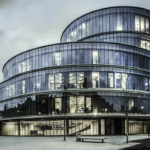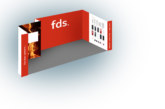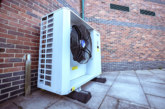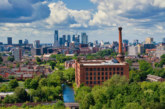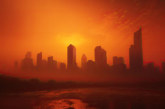Andy Lake, UK Projects Director at Pyroguard, explores the multi-functional potential of fire safety glass and how it can help push the boundaries of architectural and interior design within public buildings.
When discussing fire safety glass, it can be easy to think of it as a product with just one function. However, while its primary purpose is indeed to protect people, property and possessions in the unfortunate event of a fire, with the correct technical guidance, it is possible for a glazing system to deliver both high levels of fire protection and so much more.
Manufactured by alternating layers of toughened glass with intumescent gel interlayers, it is these interlayers that deliver the protection, causing the fire safety glass to react in the event of a fire. Yet, through the technical selection of additional specialist glass panes to be interchanged within the system — or, in the case of a double-glazed unit, the installation of a specialist counterpane — it is possible to achieve additional performance qualities.
Acoustic capabilities
Within many of our public buildings, creating open, light and contemporary spaces has become a common design trend, with glass at the heart of achieving this. However, ensuring good levels of acoustic performance is also a priority, with specifiers looking for solutions that help reduce sound transmission, in addition to meeting fire safety regulations.
Schools are a prime example; often featuring light and airy classrooms following research into the positive effect this can have on a child’s productivity levels. While replacing a solid wall with a glass partition will succeed in opening up the space and allowing more light into the room, this design choice does then require the specification of a glazing system that delivers fire protection and sound reduction properties.
Through the specification of laminated toughened fire safety glass and technical calculations around the number of glass layers used within a system, it can be carefully engineered to reduce the level of sound transmitted through, offering an enhanced acoustic performance.

Privacy and aesthetics
While the use of glass can contribute to the creation of a light and contemporary interior spaces, it does raise issues around the matter of privacy. Fire safety glass can be specified offering levels of privacy built-in. For example, it is possible for integrated blinds to be incorporated within the glazing system, or an additional glass pane with a mirror or obscure finish — or even a screen-printed glass pane — to be interchanged between the toughened glass layers.
This idea of incorporating screen-printed glass within a glazed system can be taken further still, opening up additional design avenues. Through the use of coloured, etched or printed glass interlayers it is possible to bring colour and art into a building.
Solar control
High-rise buildings with glass façades are becoming a common sight on our cities’ skylines. However, while glass is perhaps a welcome alternative to the concrete tower blocks of the 1960s, a glass-building envelope does present some challenges — primarily, how to prevent it from acting as an over-sized greenhouse.
By inserting a glass pane with a solar control coating within the larger glazed system this problem can be avoided, working to reflect the sun’s UV rays away from the building exterior. What’s more, this can also work the other way, helping to keep heat in during the winter months and preventing it from escaping through the glass.
The multi-functionality of fire safety glass is helping to push the boundaries of architectural and interior design within our public buildings, however, it is important to retain a sense of balance. It stands to reason that the more you put into a glazing system and the more you try to get out of it, the thicker and heavier the overall system will be. It is here that liaising with an experienced manufacturer, such as Pyroguard’s advanced technical team, can help specifiers satisfy both fire safety regulations and architectural design.

